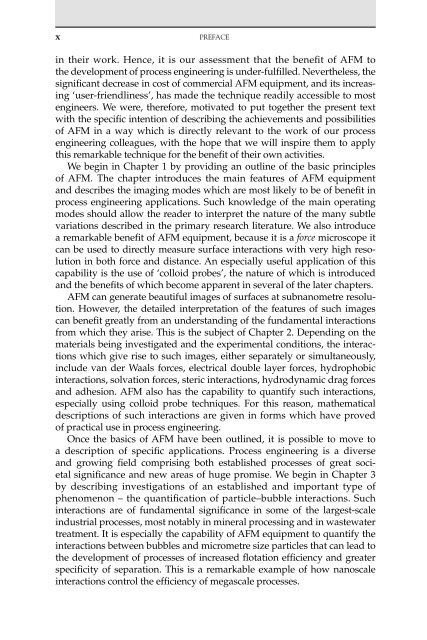W. Richard Bowen and Nidal Hilal 4
W. Richard Bowen and Nidal Hilal 4
W. Richard Bowen and Nidal Hilal 4
- No tags were found...
Create successful ePaper yourself
Turn your PDF publications into a flip-book with our unique Google optimized e-Paper software.
x Preface<br />
in their work. Hence, it is our assessment that the benefit of AFM to<br />
the development of process engineering is under-fulfilled. Nevertheless, the<br />
significant decrease in cost of commercial AFM equipment, <strong>and</strong> its increasing<br />
‘user-friendliness’, has made the technique readily accessible to most<br />
engineers. We were, therefore, motivated to put together the present text<br />
with the specific intention of describing the achievements <strong>and</strong> possibilities<br />
of AFM in a way which is directly relevant to the work of our process<br />
engineering colleagues, with the hope that we will inspire them to apply<br />
this remarkable technique for the benefit of their own activities.<br />
We begin in Chapter 1 by providing an outline of the basic principles<br />
of AFM. The chapter introduces the main features of AFM equipment<br />
<strong>and</strong> describes the imaging modes which are most likely to be of benefit in<br />
process engineering applications. Such knowledge of the main operating<br />
modes should allow the reader to interpret the nature of the many subtle<br />
variations described in the primary research literature. We also introduce<br />
a remarkable benefit of AFM equipment, because it is a force microscope it<br />
can be used to directly measure surface interactions with very high resolution<br />
in both force <strong>and</strong> distance. An especially useful application of this<br />
capability is the use of ‘colloid probes’, the nature of which is introduced<br />
<strong>and</strong> the benefits of which become apparent in several of the later chapters.<br />
AFM can generate beautiful images of surfaces at subnanometre resolution.<br />
However, the detailed interpretation of the features of such images<br />
can benefit greatly from an underst<strong>and</strong>ing of the fundamental interactions<br />
from which they arise. This is the subject of Chapter 2. Depending on the<br />
materials being investigated <strong>and</strong> the experimental conditions, the interactions<br />
which give rise to such images, either separately or simultaneously,<br />
include van der Waals forces, electrical double layer forces, hydrophobic<br />
interactions, solvation forces, steric interactions, hydrodynamic drag forces<br />
<strong>and</strong> adhesion. AFM also has the capability to quantify such interactions,<br />
especially using colloid probe techniques. For this reason, mathematical<br />
descriptions of such interactions are given in forms which have proved<br />
of practical use in process engineering.<br />
Once the basics of AFM have been outlined, it is possible to move to<br />
a description of specific applications. Process engineering is a diverse<br />
<strong>and</strong> growing field comprising both established processes of great societal<br />
significance <strong>and</strong> new areas of huge promise. We begin in Chapter 3<br />
by describing investigations of an established <strong>and</strong> important type of<br />
phenomenon – the quantification of particle–bubble interactions. Such<br />
interactions are of fundamental significance in some of the largest-scale<br />
industrial processes, most notably in mineral processing <strong>and</strong> in wastewater<br />
treatment. It is especially the capability of AFM equipment to quantify the<br />
interactions between bubbles <strong>and</strong> micrometre size particles that can lead to<br />
the development of processes of increased flotation efficiency <strong>and</strong> greater<br />
specificity of separation. This is a remarkable example of how nanoscale<br />
interactions control the efficiency of megascale processes.
















